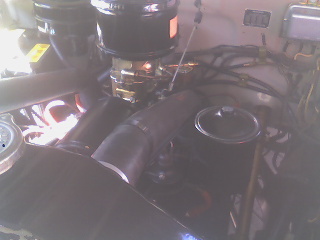QuestionQUESTION: Greetings Brad!
A friend just picked up a Convertible 1946 Mercury and is having some engine temperture issues, namely the needle goes to hot after a 5 minute ride! We are in Florida and so the car is usually driven at 70 - 85 degrees air temp.
We noticed the flathead v8 has two head mounted water pumps one on each head at the front! We were curious as to why there were two used in the design and wondered was it that they are necessary to dissipate the added exhaust heat which must pass around the cylinders to get to the exhaust manifold?
Also, since the car is based in FL should we remove the thermostat completely for warm weather driving? And finally, what should we look for before the pumps/thermostat is suspect? Any tricks for testing the temperature gauge. Car is supposedly fully restored and retains the 6 volt electrics postive ground?
Thanks in advance for your help!
Mike
ANSWER: I am a bit confused. Are the water pumps mounted to the cylinder heads or the engine block? Are the upper radiator hoses attached to the upper middle of the cylinder heads or at the front of the heads? Does the temp gage slowly climb or does it jumper from cold to hit? Let me know and we will go from there.
Brad
---------- FOLLOW-UP ----------
QUESTION: Thanks for the super fast reply Brad!
I apologize for not being specific enough about the engine configuration and the temperature rise rate! Will get those additional details to you ASAP!
Thanks again for your expertise and the rapid reply,
Mike
ANSWER: I'll be waiting.
---------- FOLLOW-UP ----------
 Upper hose on 46 merc
Upper hose on 46 merc
QUESTION: Greetings again Brad!
OK! Thanks for your patience!
Here is what I think you want to know:
a. Left and right water pumps are mounted to the front of each cylinder head.
b. Upper radiator hoses (L & R) are attached to the upper middle of each cylinder head.
c. With engine running after a 10 minute warm up trip, both upper hoses are hot and using a stethascope, we determined that both hoses are flowing coolant.
d. Removed radiator cap after 10 minutes of driving and 10 minutes of low rev idling! Coolant is an inch or so below the top of the filler neck, and we can see coolant flow at idle, and more so when revving the engine a bit!
e. There are two water temperature sending units, one with a single electrical bayonet connection on the passsenger's side head, just behind the upper hose connection and another water temperature sending unit on the driver's side head, also just behind the upper radiator hose connection and this sending unit has two bayonet connections, one which is jumped from the passenger side sending unit and the other which I expect goes to the temperature gauge! If I remove the electrical wire which goes to the temperature gauge on the driver's side sending unit, the gauge pegs to the "H" position of the gauge (right side of gauge! If I remove the jumper from the passenger side sending unit I see no measurable difference in needle position. With all electrical connections attached, after the aforementioned 10 minutes of driving and 15 minutes or so of idling, the gauge is close to pegging at the "H" but doesn't seem to get there?
Air temp today in FLorida was around 75 or so! Didn't have access to a thermometer to determine how hot the coolant actually was but, sticking my finger in the filler neck wasn't scalding, hot mind you but not scalding? Any idea what temperature reading would indicate overheating? Going to do the thermometer check tomorrow.
In closing, it appears the pumps, or at least "one pump" is pumping and since we have pretty good flow at the filler neck. I would guess the thermostat(s) are open or at least one of them anyway to allow the upper hoses to get hot and create flow to the radiator? Also, we are guessing since there are two pumps and two upper and lower hoses for each side of the engine that the coolant is therefore isolated on each side of the block and the coolant is not shared or actually flows directly between both side of the block via water jackets? That could be a stretch assumption but that's what we are thinking?
So, bottom line, we see flow, both upper hoses are hot and seem to be sending coolant to the radiator. The gauge doesn't actually peg at the "H", but pretty close to it and so we don't know if this is normal or if we have a circulation problem? Your insight would be greatly appreciated!
Thanks again!
Mike
AnswerSorry for the delay but we are traveling in search of warm. We are right now just north of Orlando in one of the RV parks on Route 27. If I were working this problem I would start with a thermometer and check the temperature of the coolant at the radiator neck. If the temperature is truely high, which I don't think the case is, then I would start by having the radiator rodded out by a radiator shop. If the temperature is normal then just make a mental note that is where the gage is at normal.
